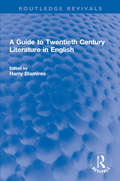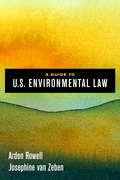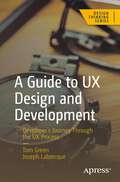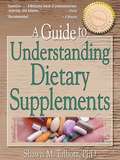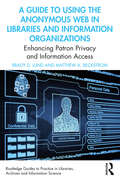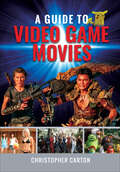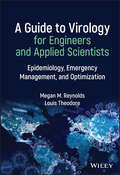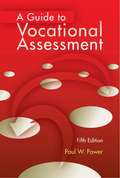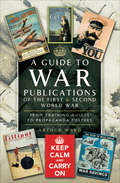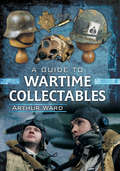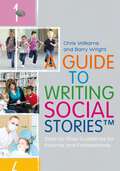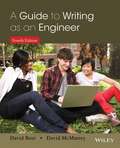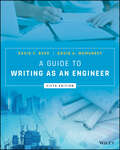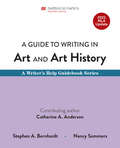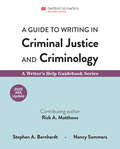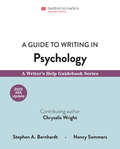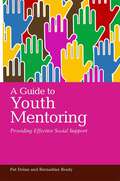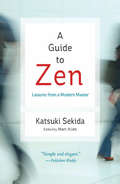- Table View
- List View
A Guide to Twentieth Century Literature in English (Routledge Revivals)
by Harry BlamiresFirst published in 1983, A Guide to Twentieth Century Literature in English is a detailed and comprehensive guide containing over 500 entries on individual writers from countries including Africa, Australia, Canada, the Caribbean, India, Ireland, New Zealand, Pakistan, Sri Lanka, and the UK. The book contains substantial articles relating to major novelists, poets, and dramatists of the age, as well as a wealth of information on the work of lesser-known writers and the part they have played in cultural history. It focuses in detail on the character and quality of the literature itself, highlighting what is distinctive in the work of the writers being discussed and providing key biographical and contextual details. A Guide to Twentieth Century Literature in English is ideal for those with an interest in the twentieth century literary scene and the history of literature more broadly.
A Guide to U.S. Environmental Law
by Arden Rowell Josephine van ZebenWritten by two internationally respected authors, this unique primer distills the environmental law and policy of the United States into a practical guide for a nonlegal audience, as well as for lawyers trained in other regions. The first part of the book explains the basics of the American legal system: key actors, types of laws, and overarching legal strategies for environmental management. The second part delves into specific environmental issues (pollution, ecosystem management, and climate change) and how American law addresses each. Chapters include summaries of key concepts, discussion questions, and a glossary of terms, as well as informative "spotlights"—brief overviews of topics. With a highly accessible structure and useful illustrative features, A Guide to U.S. Environmental Law is a long-overdue synthetic reference on environmental law for students and for those who work in environmental policy or environmental science. Pairing this book with its companion, A Guide to EU Environmental Law, allows for a comparative look at how two of the most important jurisdictions in the world deal with key environmental problems.
A Guide to UX Design and Development: Developer’s Journey Through the UX Process (Design Thinking)
by Joseph Labrecque Tom GreenGain a thorough understanding of the two pillars of any User Experience project: the mission and the process. The mission is to keep the user in mind at each step or milestone as the developer progresses through the project. The process is how that mission is accomplished through collaboration and the use of research, design and development technologies. This book walks you through a developer's journey through the UX process, from start to finish. A Guide to UX Design and Development concentrates on the intersection of what is called “DesignOps” and “DevOps.” That intersection is where collaboration between all members of the team, including stakeholders and clients, occurs and neither DesignOps nor DevOps can go beyond being considered just buzzwords if they instead silo design and development. To highlight the UX Mission and illustrate the responsibility developers also hold for the user experience, authors Tom Green and Joseph Labrecque take you through a hypothetical project involving the development of a parking app for a municipal parking authority. As the book progresses, they concentrate on the developer's journey through the whole project from discovery to product release. In this journey, you will see how developers can make an impact and contribute to the user experience. This will include such topics as why there is a need for both a user journey map and a technical journey map. The authors explain why prototyping is not as complicated as it is made out to be because it is simply an early low-cost and disposable minimal viable product that gives the developer a deep understanding of the project's intent in support of the UX Mission. You will also explore the creation and use of design systems and why the developer's role is just as important as the people who create the design system. The role and responsibility of the developer in user testing is discussed in the context of a variety of testing and assessment methods conducted to achieve the UX mission. Finally, you’ll gain an understanding of how design and development deliverables are negotiated, prepared and sent out for research at each step of the process, and how the developer is involved. What You Will Learn Understand the evolving role of the developer in a team-based environmentLearn the five stages of the UX process Discover the importance of collaboration and communication with stakeholders, designers, and developers at every stage of the processLearn a variety of design and development documents created during the UX process Who This Book Is For Developers and designers involved in the UX Process, as well as developers trying to make sense of the confusing amount of information out there regarding their role in the UX process.
A Guide to Understanding Dietary Supplements (Nutrition, Exercise, Sports, And Health Ser.)
by Shawn M TalbottWritten by one of the foremost experts on sports nutrition and performance, A Guide to Understanding Dietary Supplements takes a critical look at the dietary supplement industry. With an estimated 60 percent of adult Americans using dietary supplements every day, the need for a thorough examination of the hundreds of products on the market is long overdue. This comprehensive guide (Selected as an Outstanding Academic Title by Choice Magazine) presents straightforward analysis from a consumer's perspective, giving you the facts on more than 140 supplements and information on which supplements work (and which don't!) for a wide range of health conditions-from preventing cancer and heart disease to fighting diabetes and depression.United States Department of Agriculture surveys show that more than 70 percent of Americans fail to achieve daily recommended levels for many vitamins and minerals. With today's emphasis on fitness, millions are investing their money and health in quick-fix solutions-supplements promoted as cure-alls to right nutritional wrongs, lower the likelihood of disease, and work dietary miracles. A Guide to Understanding Dietary Supplements presents a more realistic view of supplements as neither miracle cure nor nutritional sham, but as consumer products to be accepted or rejected based on scientific fact, not fitness fantasy.A Guide to Understanding Dietary Supplements looks at the pros and cons of dietary supplements in the areas of: weight loss bones and joints energy, brain, and mood heart, eye, and gastrointestinal health male and female health cancer, diabetes, and the immune system sports and ergogenic aidsIn addition, the book presents an overview of the dietary supplement industry and the regulations that govern it and looks at the process for developing new products. Designed to cut through the confusion surrounding dietary supplements, A Guide to Understanding Dietary Supplemens is an invaluable resource for students, educators and professionals who deal with nutrition, exercise, physical education, nursing, and anyone else interested in health and fitness.
A Guide to Using the Anonymous Web in Libraries and Information Organizations: Enhancing Patron Privacy and Information Access (Routledge Guides to Practice in Libraries, Archives and Information Science)
by Brady D. Lund Matthew A. BeckstromA Guide to Using the Anonymous Web in Libraries and Information Organizations provides practical guidance to those who are interested in integrating the anonymous web into their services. It will be particularly useful to those seeking to promote enhanced privacy for their patrons. The book begins by explaining, in simple terms, what the anonymous web is, how it works, and its benefits for users. Lund and Beckstrom also explain why they believe access to the anonymous web should be provided in library and information organizations around the world. They describe how to provide access, as well as educate library users on how to utilize the anonymous web and navigate any challenges that might arise during implementation. The authors also encourage the development of library policies that guide appropriate conduct and filter content, where appropriate, in order to deter illegal activity. A Guide to Using the Anonymous Web in Libraries and Information Organizations reminds us that libraries and other information providers have a duty to educate and support their communities, while also preserving privacy. Demonstrating that the anonymous web can help them to fulfil these obligations, this book will be essential reading for library and information professionals working around the world.
A Guide to Video Game Movies
by Christopher CartonHave you ever wondered if that game you love was made into a movie? Flip this book open and find out! Explore the fascinating journey of your favorite video games as they make their way to the silver screen! This comprehensive guide contains information on over forty big-screen adaptations of popular video games, including the histories of the series that inspired them. Covering four decades of movies, readers can learn about some of the most infamous movies in video game history, with genres such as horror, martial arts, comedy and children’s animation ensuring there’s plenty of trivia and analysis to keep gamers hooked. With nearly two-hundred full color stills, posters and screenshots, the book is a go-to guide to discovering facts about some of the biggest box office hits and the most disappointing critical bombs in history. From bizarre science fiction like Super Mario Bros. to the latest big budget releases like Monster Hunter, and dozens in between, A Guide to Video Game Movies should please film buffs and die-hard game fans alike. Whether you’re looking for rousing blockbuster action, family-friendly entertainment or a late-night B-movie to laugh at with your friends, you’re bound to find a movie to fit your taste. Put down your controller and grab your popcorn!
A Guide to Virology for Engineers and Applied Scientists: Epidemiology, Emergency Management, and Optimization
by Louis Theodore Megan M. ReynoldsA Guide to Virology for Engineers and Applied Scientists A hands-on guide covering the fundamentals of virology written from an engineering perspective In A Guide to Virology for Engineers and Applied Scientists: Epidemiology, Emergency Management, and Optimization, a team of distinguished researchers delivers a robust and accessible treatment of virology from an engineering perspective. The book synthesizes a great deal of general information on viruses—including coronaviruses—in a single volume. It provides critical context that engineers and applied scientists can use to evaluate and manage viruses encountered in the environment. The fundamental principles of virology are explored with calculation details for health and hazard risk assessments. Each chapter combines numerous illustrative examples and sample problems ideal for advanced courses in environmental health and safety, pharmaceuticals, and environmental science and engineering. Readers will also find: A detailed introduction to health and hazard risk analysis and assessment that is complete with technical information and calculation details Comprehensive illustrative examples and practice problems for use by educators and professionals in training Practical discussions of virology by authors with combined experience in pharmaceuticals and environmental health and safety Thorough treatments of virology from the perspective of a professional engineer A definitive source for those working in related fields who wish to deepen their overall understanding of viruses Perfect for chemical, civil, mechanical, biochemical engineers, and applied scientists, A Guide to Virology for Engineers and Applied Scientists: Epidemiology, Emergency Management, and Optimization will also earn a place in the libraries of industrial hygiene professionals and instructors, students, and practitioners in environmental health, pharmaceuticals, public health, and epidemiology.
A Guide to Vocational Assessment 5th Edition
by Paul W. PowerThis fifth edition of A Guide to Vocational Assessment acknowledges the changes in social and economic systems facing adults with disabilities. It suggests multiple evaluation approaches and insights that can be used to change the difficult to the possible and eventually to the probable. While many chapters underscore the use of traditional evaluation approaches, other chapters operationalize vocational assessment as an individualized, creative, empowering, holistic process and experience of self-discovery.
A Guide to War Publications of the First & Second World War: From Training Guides to Propaganda Posters
by Arthur WardA &“fascinating&” guide to war propaganda of WWI and WWII, from &“Loose Lips Sink Ships&” to &“Keep Calm and Carry On&”—includes vintage images (Firetrench). A Guide to War Publications of the First & Second World War is devoted to the printed ephemera that was designed to educate, instruct, inform, and entertain during the first and second World Wars. This includes soldiers&’ Field Regulations, updates airmen received about airborne early warnings, bomb sights, and radio navigation, and materials sailors were given to help them identify enemy aircraft and operate new weapons on submarines. This comprehensive guide illustrates the large amount of material produced during the war by looking at encouraging wartime sayings such as: &“Go To IT!,&” &“Come Into The Factories,&” &“Keep Calm and Carry On,&” &“Dig for Victory,&” &“Lend A Hand on the Land,&” and &“Walk When You Can.&” While showing how other messages warned of consequences to irresponsible behavior: &“Careless Talk Cost Lives,&” &“Loose Lips Sink Ships,&” &“Keep It Under Your Hat,&” and &“Be Like Dad, Keep Mum.&” Arthur Ward gives information on what propaganda was produced, what items are still available and where to find them, and how to conserve and store vintage printed items.
A Guide to Wartime Collectables: An Enthusiast's Guide To Militaria
by Arthur WardMake sure you&’re getting the genuine article with this &“well-illustrated&” guide and &“must read&” for collectors of twentieth-century military memorabilia (Antiques Diary). Written by a longtime collector, A Guide to Wartime Collectables tells readers what to look for when looking for authentic military items. From army badges to gas masks, this book covers the major types of twentieth-century military collectables. Arthur Ward shows what these items look like and what new collectors should be looking for to ensure they&’re purchasing authentic artifacts and not reproductions. This book also includes photographs of the author&’s collection that feature important details such as insignias and other regalia. &“A very useful book written by an author who knows his stuff.&” —The Armourer
A Guide to Web Development Using Adobe® Dreamweaver® CS5, with Fireworks® CS5 and Flash® CS5
by Jan MarrelliA Guide to Web Development Using AdobeA(R) Dreamweaver CS5 teaches Flash Fireworks and Dreamweaver in a full-color format. Students learn about Web development HTML CSS and how to use Dreamweaver to create websites. Each chapter discusses concepts which are then reinforced within hands-on activiesAll explanations problems and answers have been produced using Dreamweaver CS5 Fireworks CS5 and Flash CS5. Students are introduced to the history terminology and concepts of networks and the Internet. Email protocol and careers associated with web development are also discussed.
A Guide to Western Civilization, or My Story
by Joe Bob BriggsThis book will change your life. It's got chapters in here about how Joe Bob invented the American topless bar, how he solved the Kennedy assassination, how he learned to sin with fat girls, and of course how he became the monstrous country-western star he is today. This book also contains a complete history of the world.
A Guide to Writing Social Stories™: Step-by-Step Guidelines for Parents and Professionals
by Chris Williams Barry WrightSocial StoriesTM are a widely used and highly effective intervention for supporting children on the autism spectrum, but it can feel overwhelming to follow all the rules put in place to create personalised stories. Developed with the input of parents and professionals, and informed by new Social Stories research, this is a comprehensive, clear, easy step-by-step guide to writing effective personalised Social StoriesTM that give children social information, creating many benefits for them. The book includes many examples of real Social Stories created for children by parents and teachers working together, and handy downloadable checklists that highlight the essential components of a Social Story, helping to ensure that each story you write achieves the best possible results.
A Guide to Writing as an Engineer
by David Mcmurrey David BeerWritten for engineers, this book provides more than technical know-how and focuses on how to be an effective communicator. This new edition helps to eliminate the glitches that trip up the busy reader or listener, causing annoyance, confusion, or misunderstanding'so that their writing and speech are crystal clear. This text also focuses on the technical writing and speaking issues encountered in day to day work, writing reports, business letter, memoranda, proposals, emails, presentations, and more. The new edition includes new coverage of social media, including coverage of popular forms, best practices, dangers and ethics of using social media, and expanded coverage of informal communication.
A Guide to Writing as an Engineer
by David Beer David McMurreyEveryone knows that engineers must be good at math, but many students fail to realize just how much writing engineering involves: reports, memos, presentations, specifications―all fall within the purview of a practicing engineer, and all require a polished clarity that does not happen by accident. A Guide to Writing as an Engineer provides essential guidance toward this critical skill, with practical examples, expert discussion, and real-world models that illustrate the techniques engineers use every day. <P><P>Now in its Fifth Edition, this invaluable guide has been updated to reflect the most current standards of the field, and leverage the eText format to provide interactive examples, Engineering Communication Challenges, self-quizzes, and other learning tools. Students build a more versatile skill set by applying core communication techniques to a variety of situations professional engineers encounter, equipping them with the knowledge and perspective they need to succeed in any workplace. Although suitable for first-year undergraduate students, this book offers insight and reference for every stage of a young engineer’s career.
A Guide to Writing in Art and Art History with 2021 MLA Update: A Writer's Help Guidebook Series
by Nancy Sommers Stephen A. BernhardtThis ebook has been updated to provide you with the latest guidance on documenting sources in MLA style and follows the guidelines set forth in the MLA Handbook, 9th edition (April 2021).A Guide to Writing in Art and Art History, part of the Writer’s Help Guidebook Series, offers writing and research support for students writing in the discipline. This compact yet comprehensive guidebook provides the value students want with the essential instruction they need to complete writing tasks successfully. Students will find advice on how to think, read, research, and design and write papers and projects like an art professional.
A Guide to Writing in Criminal Justice and Criminology: A Writer's Help Guidebook Series
by Nancy Sommers Stephen A. Bernhardt Rick A. MatthewsA Guide to Writing in Criminal Justice and Criminology.
A Guide to Writing in Nursing and Health Professions: A Writer's Help Guidebook Series
by Nancy Sommers Stephen A. Bernhardt Caitlin KiltsWith 2020 APA Update A Guide to Writing in Nursing and Health Professions, part of the Writer’s Help Guidebook Series, offers writing and research support for students writing in the discipline. This compact yet comprehensive guidebook provides the value students want with the essential instruction they need to complete writing tasks successfully. Students will find advice on how to think, read, research, and design and write papers, and projects and presentations like a nurse or health professional. Coverage includes the following topics, all focused on the specific needs of writers in nursing and health professions: * Writing process * Conventions in the discipline * Integrating and evaluating sources * Documentation style required in the discipline--with plenty of models * Sample student writing
A Guide to Writing in Psychology: A Writer's Help Guidebook Series
by Nancy Sommers Stephen A. Bernhardt Chrysalis WrightWith 2020 APA Update A Guide to Professional Writing, part of the Writer’s Help Guidebook Series, offers writing and research support for students writing in the discipline. This compact yet comprehensive guidebook provides the value students want with the essential instruction they need to get their writing tasks completed successfully. Students will find advice on how to think, read, research, design and write papers, projects and presentations like a professional writer. Coverage includes the following topics, all focused on the specific needs of professional writers: * Writing process * Conventions in the discipline * Integrating and evaluating sources * Documentation style required in the discipline--with plenty of models * Sample student writing
A Guide to Writing in the Sciences
by Patricia Patchet-Golubev Andrea A. GilpinWhile teaching writing to undergraduate science students, Gilpin and Patchet-Golubev discovered that although many relatively sophisticated manuals for scientific writing exist, most are aimed at mainly professionals or specialists and are of little practical use to the majority of students. This introductory guide fills that large gap.Direct and friendly in tone the book provides clear and concise explanations of the basic elements of scientific writing required of students. The various genres are detailed -- in particular lab reports and research essays - as well as scientific articles, poster presentations, proposals, and even essay exams. Similarities and differences among these genres are underlined in order to illustrate structural principles and to provide practical writing tips. A detailed chapter covers the elements of grammar and punctuation that are fundamental to all good writing; it also outlines some key points about scientific style in particular.Using accessible language throughout, the authors organize their material with helpful lists, copious examples, and boxed writing and research tips. There are several useful appendices (including a classification chart of organisms and an international units conversion chart), an index, and selected bibliography on science and technical writing. Unique in its field, this guide offers a practical and valuable guide to the basic principles and conventions of science writing.
A Guide to Your History Course: What Every Student Needs to Know "
by Vincent Alan ClarkHistory students are like travelers in a foreign country. They can benefit from a guidebook that provides orientation, information about important sites, and helpful information for solving practical problems. "A Guide to Your History Course" is designed to show them the way.
A Guide to Youth Mentoring
by Pat Dolan Bernadine BradyYouth mentoring can be an effective way of supporting troubled youth, helping them sustain positive mental health, cope with stress, and lead successful lives through adolescence and into adulthood. This book is a comprehensive guide to youth mentoring programmes, illustrating how, if managed well, they can increase the social support available to young people. It outlines the objectives and benefits of mentoring, how it works, and how to mentor successfully. Youth mentoring in community and school settings is covered, as well as mentoring for vulnerable youth. The book illustrates different mentoring models and provides practical strategies for assessing, setting up, and monitoring the mentoring relationship and its outcomes for the young person. The challenges and difficulties associated with mentoring programmes and strategies to overcome them are also addressed. This will be an essential guide for anyone working with young people, including youth workers, social workers, residential care staff, foster carers, community development workers, teachers and community police.
A Guide to Zen
by Katsuki SekidaVery few masters of Zen have been writers; very few writers about Zen have been masters. Katsuki Sekida was both. His finest work, Zen Training, remains one of the most comprehensive books on Zen ever written in English. In A Guide to Zen, Marc Allen, a former student of Sekida, presents selections of the original work to produce a beautifully readable, brilliant guide to Zen meditation. Includes a summary of Zen and a complete course in Zen meditation, with specific practices and commentaries on higher states of consciousness and on a classic series of Zen pictures.
A Guide to Zona Pellucida Domain Proteins
by Eveline S. Litscher Paul M. WassarmanThis book provides a coherent, clear, and uniform presentation of structural, genetic, molecular, and biochemical information available for the zona pellucida domain protein family, which impact pathologies such as infertility, deafness, and cancer. Furthermore it: Details information about the structure and function of the ZP domain in ZPDC-proteins Provides illustrations of the organization of ZPDC-proteins, the genes that encode the proteins, and examples of mutations in the ZP domain that cause diseases Speculates as to the evolution of the ZP domain and potential therapeutics for diseases stemming from ZP domain mutations Addresses mammalian and non-mammalian systems
